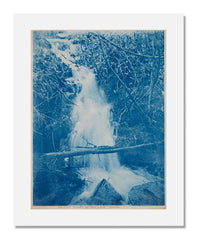One of the earliest photographic processes is the cyanotype, invented in 1842 by Sir John Herschel. Fascinated by the new medium of photography, the British astronomer and chemist found himself drawn to investigating its possibilities. He solved the problem of finding a fixing agent to stabilize photographic prints (the so-called hypo) and coined the terms negative and positive for the field. He then discovered a process by which he could make color photographs on paper in great detail but only in the shade of blue. The invention was based on the reaction of certain iron salts to light, and he named it the cyanotype (after the Greek cyan, meaning "deep blue"). One of the advantages of the process was its simplicity: Only a few chemicals plus water and sunlight were needed to yield visions of startling beauty. Anna Atkins, daughter of a friend of Herschel's, was among the first to use the process. A botanist, she initially made cyanotypes from pieces of seaweed that she dried, laid on the sensitized paper, and exposed to light. Since her prints involved no negative, they were unique. She compiled them into what was the first photographically illustrated book, British Algae: Cyanotype Impressions, issued in sections from 1843 to 1853. Atkins went on to record a number of other specimens, especially ferns and flowering plants. While privately published in a limited number of copies, her photographs combine artful beauty and serious science.
Anna Atkins, daughter of a friend of Herschel's, was among the first to use the process. A botanist, she initially made cyanotypes from pieces of seaweed that she dried, laid on the sensitized paper, and exposed to light. Since her prints involved no negative, they were unique. She compiled them into what was the first photographically illustrated book, British Algae: Cyanotype Impressions, issued in sections from 1843 to 1853. Atkins went on to record a number of other specimens, especially ferns and flowering plants. While privately published in a limited number of copies, her photographs combine artful beauty and serious science.
Henry Peter Bosse took a similar approach when he used the process several decades later. Employed as a draughtsman for the U.S. Army  Corps of Engineers, Bosse was enlisted from 1882 to 1892 to draw scenes of the Mississippi River, and the alterations that the corps made to it, from St. Paul to St. Louis. In addition to drawn depictions, he exposed over three hundred negatives, thoroughly recording the water's shores, ships, and bridges. The cyanotype had just started to become a standard in mapmaking and architectural firms (for "blueprints"), so he was familiar with it. Contact printing his images as ovals, he assembled them in albums titled Views on the Mississippi River between Minneapolis, Minn. and St. Louis, Mo. 1883-1891. Bosse's work offered a picturesque documentary record of Mark Twain's famous river.
Corps of Engineers, Bosse was enlisted from 1882 to 1892 to draw scenes of the Mississippi River, and the alterations that the corps made to it, from St. Paul to St. Louis. In addition to drawn depictions, he exposed over three hundred negatives, thoroughly recording the water's shores, ships, and bridges. The cyanotype had just started to become a standard in mapmaking and architectural firms (for "blueprints"), so he was familiar with it. Contact printing his images as ovals, he assembled them in albums titled Views on the Mississippi River between Minneapolis, Minn. and St. Louis, Mo. 1883-1891. Bosse's work offered a picturesque documentary record of Mark Twain's famous river. The decorative simplicity of the cyanotype made it popular among artists of the Arts and Crafts movement around 1900. One of these was Arthur Wesley Dow, an influential painter and printmaker who was fascinated with Japanese art and design and who—through his teaching and his book Composition (1899)—helped establish key elements of modernism for American art. In his art, Dow specialized in poetic views in and around his hometown of Ipswich, Massachusetts. He found the cyanotype particularly appealing for its bright color and because it resembled the indigo present in many Japanese prints. His talent for creating images of playful geometry is apparent in these compositions.
The decorative simplicity of the cyanotype made it popular among artists of the Arts and Crafts movement around 1900. One of these was Arthur Wesley Dow, an influential painter and printmaker who was fascinated with Japanese art and design and who—through his teaching and his book Composition (1899)—helped establish key elements of modernism for American art. In his art, Dow specialized in poetic views in and around his hometown of Ipswich, Massachusetts. He found the cyanotype particularly appealing for its bright color and because it resembled the indigo present in many Japanese prints. His talent for creating images of playful geometry is apparent in these compositions.
For all three artists, the cyanotype, with its arbitrary, decorative, and intense hue, was a perfect tool for combining accurate representation and poetic metaphor.
Written by Anne E. Havinga, Estrellita and Yousuf Karsh Senior Curator of Photographs, and originally published in Blue: Cobalt to Cerulean in Art and Culture. Edited for the web by Jacob M. Rochford.
Interested in buying cyanotypes from any of these featured artists? Click below to see the full details for each print. View the whole collection here.
